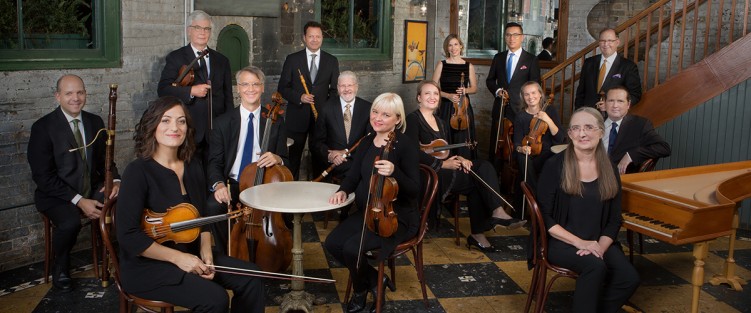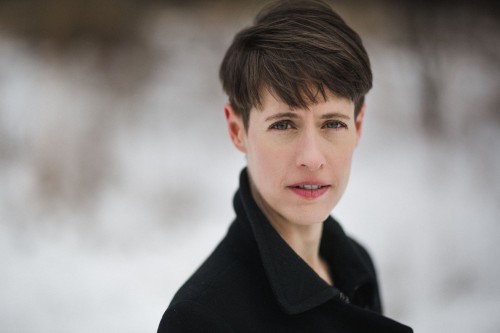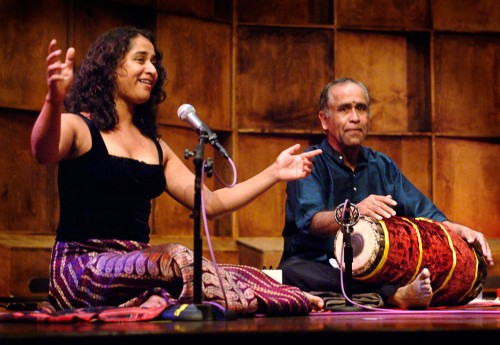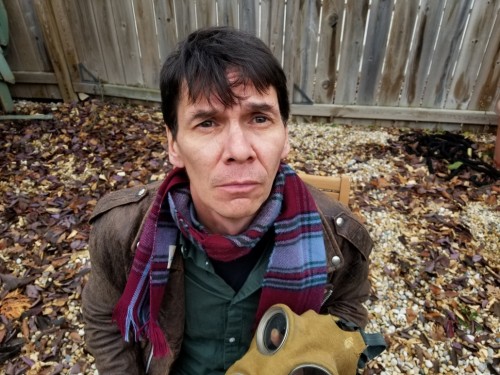 It’s not always a good idea, sitting down for only your second chat with someone, to start off by reminding them of exactly what they told you the first time round, especially if, as in this case, 18 hectic months have elapsed between conversations. But this time it worked out just fine.
It’s not always a good idea, sitting down for only your second chat with someone, to start off by reminding them of exactly what they told you the first time round, especially if, as in this case, 18 hectic months have elapsed between conversations. But this time it worked out just fine.
“In May 2017, the last time we talked,” I reminded Elisa Citterio, Tafelmusik’s music director, “you told me that you were hoping for life here to be, perhaps more busy, but less crazy, than before, and I’d like to come back to that. But you also said something very interesting about repertoire, and this is where I’d like to start. You said ‘We can’t live and die by one hundred years of [Baroque] repertoire. We are strings, two oboes, bassoon and continuo, so there are limits to the core repertoire available, and so it’s important for an orchestra like Tafelmusik to touch different periods, to educate the ear. Period playing can lead to illuminating performances of a much wider range of music – Haydn, Schumann, Brahms, Verdi. Period playing can strip away the denseness of the 19th-century sound. You get to listen for different things.”
In May 2017, we had squeezed in a hastily arranged interview in The WholeNote office three months before she officially took the Tafelmusik reins for a first season that was already significantly cut and dried in terms of repertoire. This time we were poring over the details of a 2019/20 season, about to be announced, that will, for better or for worse, be seen as well and truly hers.
“When I took on this role” she said, “I left La Scala Theatre where I had been playing for many, many years, all kinds of repertoire; at at the same time, I was playing a lot of Baroque music with other ensembles. So my whole life has been divided between different repertoire, and in my personal experience I can say absolutely that each piece of the picture connects to another one. I can’t say that playing Brahms and Wagner made coming back to Baroque music easier or more difficult. But I have to say I am curious to see how it would be, in the other direction, if musicians in conservatories were trained from early music forward, instead of the other way around.”
Her own training, she freely admits, was not the way she would like things to be. “Like most musicians,” she says, “I did things in reverse. I was trained to play caprices from the 18th and 19th century, and concertos of the 19th and 20th century, before going back in time to Mozart and eventually Bach. So it was a lot of jumping around and more focused on technical issues than on musical essentials.” It was only when she started Baroque violin, she says, that she started to connect things musically, because of the way Baroque violin practice was inextricably connected to imitation of the human voice – “to pronunciation, to consonants and vowels, to syntax. Musicians playing violins, cornettos, had to try to imitate the voice, so this changes fundamentally the way one approaches technique.”
Going back to these roots, as far back as madrigals, she says, began to influence her modern playing in profound ways, day after day and step by step. It wasn’t a magic formula or shortcut though. Finding her way back to classical and Romantic repertoire took a lot of study all over again. But the changes in her playing were fundamental. “Out of it all,” she says, “what I trusted, what I still trust, is that a Baroque orchestra has a sort of mission; it is unlike modern orchestras approaching Baroque repertoire, where the results might sound nice, but there is still something missing, because they simply don’t have the right instruments. Some things are fundamental to Baroque music that can only be achieved with gut strings and with historical wind instruments based on the voice.”
And just because there’s an argument to be made that a modern orchestra can’t travel back in time, it doesn’t mean that the reverse argument applies. After all, modern orchestras used gut strings right up to the time when, grisly fact, world wars saw the end to a reliable supply of gut strings, with the commodity commandeered for sutures.
“So, Wagner was writing for orchestras using gut strings,” she says. “And at La Scala we played operas at historically accurate pitch … I feel that if Tafelmusik does not take what we do to the limit, the edge of where we can go, not as a novelty, but consistently, with a process to arrive there, it would be a pity. I think we can really give something new for this music. We are not the first, I am not saying that. But we are one of the few. I have played with orchestras around the world and I can say that Tafelmusik can do great and huge work on this kind of music. But step by step.”
Just as finding her way back to classical and Romantic repertoire took a lot of study all over again for Citterio, the coming season’s excursion into the 19th century is not going to be a picnic for the orchestra. “It will be work,” she says, “and we will workshop for it. But Tafelmusik musicians are well informed, so that is a big start. We will concentrate only on the repertoire we are going to play in the coming season, but it is still a lot. For example, the way to shift among positions on the violin alters over the years. In Vivaldi a shift should leave a note as cleanly as possible. In the Romantic repertoire I am trying to connect the voice with a portamento going up and down; also rubato is quite different in the different periods; and the strokes are different; and we have many different kinds of accents that we have to know how to read, because earlier an accent had a different meaning. So this workshop will be really to understand how to work on these technical issues together. And also how to deal with these busy scores, because Tchaikovsky and Brahms wrote a lot on their scores! If you look at a Castello or Fontana score, then at Brahms, the world has changed totally, from nothing to everything.”
Small Steps and Giant Leaps
Citterio is describing methodically what she calls “small steps” the ensemble will be taking to prepare for the “mission” ahead but, from an audience point of view, 2019/20, styled “Old Meets New” in their brochure, looks like more of a giant leap. Old Meets New head on is more like it, starting from the very first concert of the season in which Tafelmusik tackles a string symphony by the teenaged Felix Mendelssohn, as well as the Scherzo from his A Midsummer Night’s Dream, arranged by Citterio’s composer brother, Carlo Citterio, en route to tackling the music of Tchaikovsky (his Serenade for string orchestra) for the very first time.
The program will also feature a world premiere by Canadian composer Andrew Balfour, as the brochure says, “in keeping with our season theme of the new informing the old, and the old informing the new.”
It’s a lot to unpack, starting with the notion of Tafelmusik commissioning no fewer than six new works over the course of a single season, four of them by Canadian composers. (In addition to Balfour, the season will also include premieres from James Rolfe, Guido Morini, Cecilia Livingston, Grégoire Jeay, and Vittorio Ghielmi.
 “It’s just a first example of trying to start the process of realizing my vision of what this orchestra can be,” Citterio says. “I want to support new composers, including strongly believing in including new commissions. We must remember that this ‘new thing’ is actually very old, because one thing about Baroque music is that, for the players and for the audience, it was almost all newly composed – all music was like a premiere. So how else do we get the same feeling today as players? Or as audiences? There are many composers who can write for our instruments with a style that is really compatible, or sometimes with some new influences. I played a lot of great music when I was in Italy, just written for our instruments, sometimes in Baroque style, sometimes in a later style, and the audience just loved it. There’s nothing wrong with someone who wants to write for gut strings because they love the sound! Or for harpsichord. I mean, piano is a wonderful instrument, but we still have the harpsichord as a living instrument, or the viola da gamba ... I played one time this concerto grosso written by an Italian composer, a premiere, and it was written for harpsichord, two violins, viola, gamba and two recorders, and it was amazing; there was an obvious influence from Corelli’s Concerto grosso, but there were other subtle nuances from Romantic or later repertoire. The harpsichord, gamba and recorders all had solos, and the mix was stunning and the audience loved it, because it was written for the voices of the instruments. That was 15 years ago and at that time I thought we must give space to composers.”
“It’s just a first example of trying to start the process of realizing my vision of what this orchestra can be,” Citterio says. “I want to support new composers, including strongly believing in including new commissions. We must remember that this ‘new thing’ is actually very old, because one thing about Baroque music is that, for the players and for the audience, it was almost all newly composed – all music was like a premiere. So how else do we get the same feeling today as players? Or as audiences? There are many composers who can write for our instruments with a style that is really compatible, or sometimes with some new influences. I played a lot of great music when I was in Italy, just written for our instruments, sometimes in Baroque style, sometimes in a later style, and the audience just loved it. There’s nothing wrong with someone who wants to write for gut strings because they love the sound! Or for harpsichord. I mean, piano is a wonderful instrument, but we still have the harpsichord as a living instrument, or the viola da gamba ... I played one time this concerto grosso written by an Italian composer, a premiere, and it was written for harpsichord, two violins, viola, gamba and two recorders, and it was amazing; there was an obvious influence from Corelli’s Concerto grosso, but there were other subtle nuances from Romantic or later repertoire. The harpsichord, gamba and recorders all had solos, and the mix was stunning and the audience loved it, because it was written for the voices of the instruments. That was 15 years ago and at that time I thought we must give space to composers.”
So they are trying to choose composers who already have a sense of Tafelmusik’s instruments, or really want to find out. And the process of outreach into the wider music for sources to assist them in finding composers has been a valuable exercise it its own right – Soundstreams, for example, led them to Cecilia Livingston. “Best of all, I am really looking forward it, because it will be a surprise for me too, as a player,” Citterio says. “And that is very Baroque.”
As important as the fact of there being new commissions, will be the contexts in which they will be presented. In the season’s ninth program, for example, Quebec flutist Grégoire Jeay’s new work will be designed to lead directly into Citterio’s own arrangement for orchestra (“I am still working on it!” she says) of Bach’s Goldberg Variations.
“But you talked earlier about the power of period playing to cut through the complexity of someone like Tchaikovsky,” I say. So isn’t setting the Goldberg for orchestra the opposite of that – taking something pure and muddying it? I remember, last time we talked you called that kind of thick sound minestrone Wagneriana, and we decided the best English translation was ‘Wagnerian pea soup’?”
She laughs. “Yes I remember. But this is not the same thing. The rearrangement of music from many instruments to few and few to many is a very old idea, and common in Baroque. Bach, for example, arranged violin sonatas for lute and for harpsichord. Or another example, in our fifth program, for example, we are going to hear opera music arranged for eight winds. And all these arrangements, the Bach and the Harmonie, were done at the time, so the idea of the Goldberg orchestral arrangement is not so novel. On our tour out west, an all-Bach program, we included a couple of arrangements of variations and I have in the past already recorded a version of the Goldberg for string quartet and harpsichord. More than that, I would say with Bach the music is beyond the specific instruments. It is just so pure in its harmony and counterpoint.”
That fifth program Citterio is referring to, by the way, is titled “Gone with the Winds,” calling to life a popular form of ensemble in Haydn, Mozart and Beethoven’s day. Hits from the latest operas were arranged for groups of wind musicians called Harmonie who performed in the homes of the rich, and in spas, pubs and pleasure gardens for the public, “the juke box of the 18th century.” Commissioned composer Cecilia Livingston, whose current major project is a full-length opera with TorQ Percussion Quartet and Toronto’s Opera 5 should fit right in!
But Will They Follow?
Baroque arrangement of Mendelssohn and Tchaikovsky and the interpolation of commissioned new works are about as far forward as Tafel will travel in time. In the 2019/20 season anyway. But the “Old Meets New” season moniker gets a vigorous workout in a host of other ways.
 There is yet another themed program, titled The Indigo Project, from the endlessly inventive and curious mind of Alison Mackay, this time in collaboration with father/daughter duo of Suba and Trichy Sankaran, tracing the significance of the introduction into 17th-century Europe of indigofera tinctoria, the indigo dye that provided both the royal blue of the Bourbon courts and the colour of the cotton fabric worn by the common folk, known as denim. Ancient history with profound contemporary implications.
There is yet another themed program, titled The Indigo Project, from the endlessly inventive and curious mind of Alison Mackay, this time in collaboration with father/daughter duo of Suba and Trichy Sankaran, tracing the significance of the introduction into 17th-century Europe of indigofera tinctoria, the indigo dye that provided both the royal blue of the Bourbon courts and the colour of the cotton fabric worn by the common folk, known as denim. Ancient history with profound contemporary implications.
Other programs dig into the centuries before Baroque in the same way the Mendelssohn/Tchaikovsky program pushes past it. Or introduce us to a composer (Antonio Lotti) whose direct influence on composers like Bach and Handel was evidently as profound as history’s silence where Lotti is concerned … the list goes on.
Engaging as it all promises to be, the jury is out on whether Tafelmusik’s audience will follow where the orchestra under Citterio clearly wants to go. And it’s clear that Tchaikovsky is not the end of the road. Citterio herself agrees that only time will tell. But she knows what she thinks about it: “I truly hope audiences will be happily surprised by it all. I think I am getting to know them better. I understand it will take time. And that some come to Tafelmusik only to hear Baroque music, I know it is only one story, but I like it: It was after we did Mozart’s Symphony No.40, which everyone does, and everyone knows. It’s everywhere. And where probably every audience member expects to hear it a certain way. So we tried to clear the score, to give it a transparency, taking advantage of our instruments, dynamic, articulation, pronunciation even (in German, of course). And one member of the audience who goes to the TSO all the time and likes that kind of style more for this kind of classical and Romantic repertoire came to me and said ‘today I discovered a new Mozart, and I don’t want to stop. I could hear each instrument and detail.’ I was so happy to have feedback like that.”
“So right at the beginning you said you were hoping for ‘busier perhaps, but less crazy,” I say, to bring it full circle. “Crazy busy!” she replies, with a smile. Not crazy the way Italy was, where there are great talents but not, shall we say, well organized as a team. Yes I am busier than I should be, I have a baby but everything is organized, and well organized, so busier is definitely easier.”
David Perlman can be reached at publisher@thewholenote.com.




